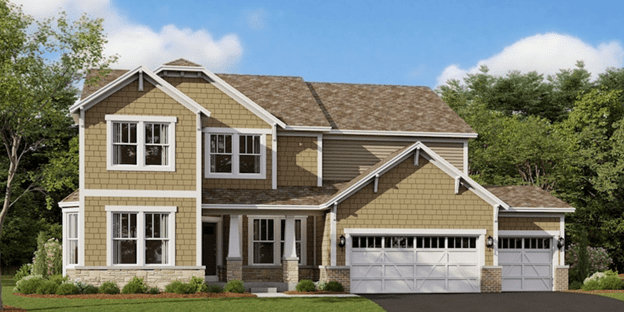Dennis Rodkin
Crain’s Chicago Business
May 6, 2024

Credit: Little Realty This rendering shows the four-bedroom Sutcliffe model at M/I Homes’ Hawthorn Woods Country Club development. At least two sold during the first quarter, at $822,000 and $890,000.
The number of new subdivisions under construction in the Chicago area is the lowest it’s been at any point in the 21st century, a new report shows.
That’s despite gains in prices and the number of sales for those builders who have subdivisions going, according to a look at the region’s first-quarter new-home market from Tracy Cross & Associates, a homebuilding consultancy based in Schaumburg.
Two decades ago, people who were shopping for new homes “had over 1,000 developments to choose from,” said Erik Doersching, CEO of Tracy Cross. “Now it’s under 250.”
This means homebuyers can’t count on builders to plug the inventory gap and bring home prices down. At a time when the inventory of existing homes for sale is epochally low because many homeowners have low-interest mortgages they don’t want to let go of, buyers’ interest in new construction is rising.
But “supply is not going to keep up with demand,” Doersching said.
The reasons for the decline, Doersching and others have told Crain’s repeatedly over the years, include a high level of regulation of getting land entitled and on construction, a pullback from living on the outer fringe of the metro toward more urban living, shallow population growth and the loss of local homebuilding firms “willing to push construction here,” as Doersching said today. At least 75% of all metro-area new-home sales are by five major national builders, all of which have busier markets in Southern and Western states.
In the first three months of the year, there were 247 active developments of 10 homes or more in the metro area, down from 251 in the same period last year and the lowest in Cross’ records, which stretch back to 2001.
The number peaked at 1,285 in 2007. What’s under construction now is about one-fifth of that.
Nationwide, it’s a different story: New-home construction is well above its highest levels from the early 2000s, according to the U.S. Census Bureau. The number of new homes built in 2023 across the country was about 22% higher than the old peak, in 2005.
For its studies, Cross includes in the metro area everything from Kenosha County, Wis., south to Will County, and from Lake Michigan to DeKalb County, an area that in the early 2000s appeared to define the sphere of growth anchored by Chicago.
Cross counts only those developments that have 10 homes or more, including houses, condos and townhouses. It doesn’t capture units that are built in ones or twos in city and suburban neighborhoods, but there’s little chance that those make up the difference from 20 years ago.
Builders sold 1,410 newly built homes in the first quarter of the year, according to Cross’ report. That’s up more than 17% from the same time in 2023.
Sales of houses were up over 31% and accounted for all of the growth in new-home sales. Builders sold 945 single-family homes in the quarter, an increase of 225 sales over the same time last year, while sales of condos were down by 17 units, to 465. It was a 3.5% decrease.
The average price of new homes sold in the quarter was a little under $488,000, an increase of 5.6% from about $462,000 in the first three months of 2023.
Of the five big national builders who dominate the suburban homebuilding scene here, four recorded double-digit price growth in the first quarter of 2024 compared to a year ago, according to the Cross report. They are D.R. Horton, up 22.1%; Lennar, up 20%; M/I Homes, up 17%; and PulteGroup/Del Webb, up 15.8%.
Demand, Doersching said, “is obviously out there.” But builders aren’t rushing in to meet it.
The national homebuilding firms all make a practice of declining Crain’s request for comment on these quarterly reports.
